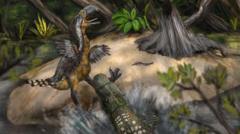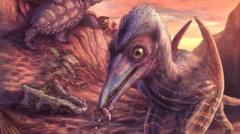Researchers have revealed a captivating tale of survival and predation in an ancient ecosystem, centered around a terror bird, a top predator that roamed the earth 13 million years ago. Fascinating teeth marks on a fossilised leg bone linked to this avian giant, known to reach heights taller than humans, indicate that it may have been killed by an even larger predator—a caiman.
In a groundbreaking study recently published in the journal Biology Letters, palaeontologists from Colombia utilized 3D digital scans of the bite marks on the fossilised bone to establish a connection to an extinct crocodile-like reptile. These findings suggest that the terror bird encountered a catastrophic fate during what scientists interpret as a "battle to the death."
The leg bone, uncovered in Colombia's Tatacoa Desert over 15 years ago, offers a window into the humid swamps where these creatures once thrived. Standing approximately 2.5 meters tall, the terror bird wielded incredibly powerful legs and a hooked beak, ideal for seizing prey. Lead researcher Andres Link notes that while it remains unclear whether this particular terror bird died during the attack or was scavenged afterward, the absence of healing signs on the bite marks strongly indicates a fatal encounter.
The collaborative efforts of Dr. Link’s team and local fossil collector César Augusto Perdomo led to the detailed analysis of the bone, which has now been identified as belonging to the rare terror bird species. The researchers found that the teeth marks most closely resembled those of the extinct caiman species Purussaurus neivensis—an imposing predator that could grow up to five meters in length and lay in ambush, much like today’s crocodilians.
Such interactions between apex predators elucidate the vulnerabilities that even the mightiest creatures faced within their ecosystems, contributing to our understanding of prehistoric life. Dr. Link emphasized the significance of each fossil, stating that "every piece of a body helps us to understand so much about life on the planet in the past." This discovery not only highlights the perilous world of terror birds but also enriches our knowledge of the complex web of life that existed millions of years ago.


















